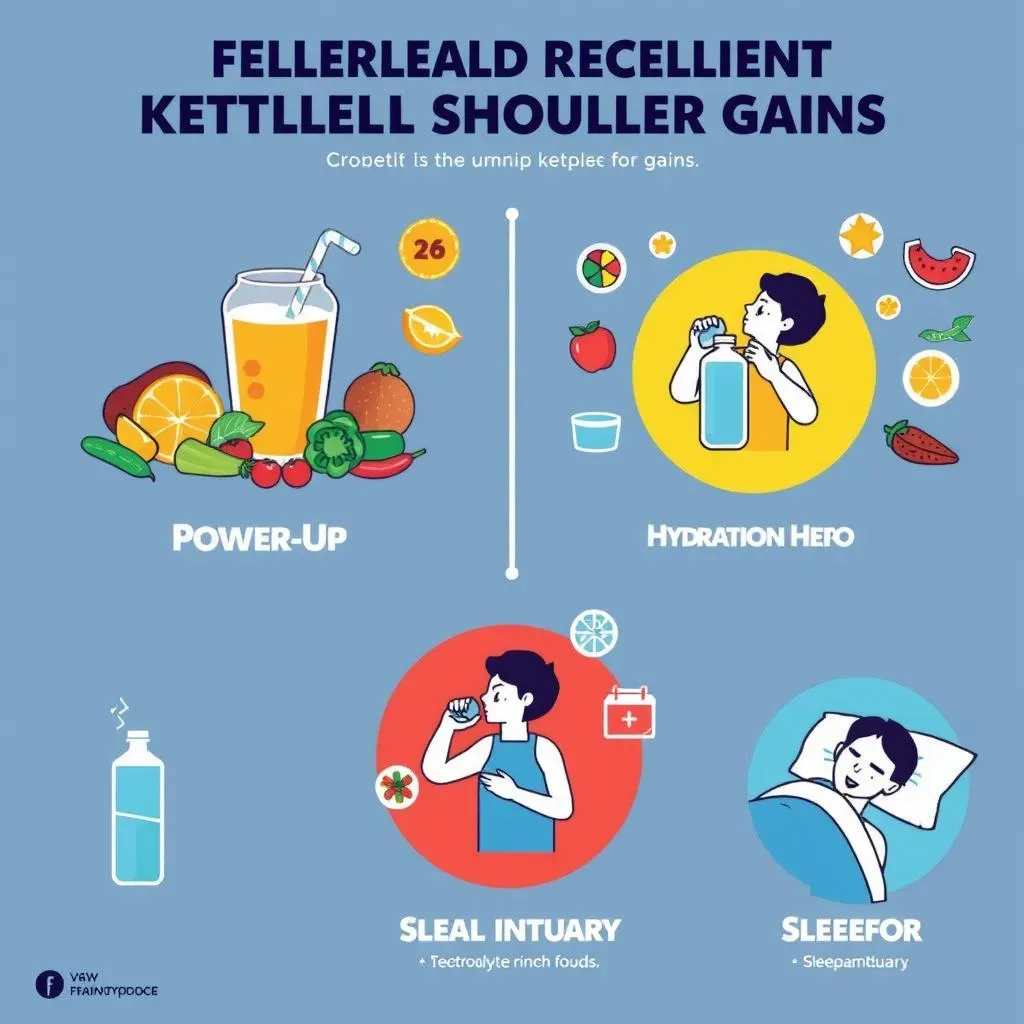Table of Contents
Ready to carve some serious definition into your shoulders? Forget endless sets of dumbbells; it's time to grab a kettlebell. This isn't just another workout fad. A well-designed kettlebell shoulder workout can unlock strength, stability, and a range of motion you never thought possible. We're diving deep into why kettlebells are the secret weapon for shoulder development, exploring the key exercises that target every angle, and arming you with the knowledge to train safely and effectively. Whether you're a seasoned athlete or just starting your fitness journey, get ready to discover how to build powerful, resilient shoulders with the power of the kettlebell. We'll break down the anatomy, master the movements, and even cover the nutrition and recovery strategies you need to maximize your results. So, ditch the excuses, pick up a kettlebell, and let's get to work!
Why Your Shoulders Will Thank You for This Kettlebell Workout

Why Your Shoulders Will Thank You for This Kettlebell Workout
Beyond the Beach Muscles: Real-World Strength
Let's be honest, a lot of shoulder workouts focus on aesthetics. But a kettlebell shoulder workout is about building functional strength that translates to everyday life. Think about it: carrying groceries, lifting luggage, reaching for that top shelf. All these actions require strong, stable shoulders. Kettlebells, with their offset center of gravity, force your shoulder muscles to work harder to control the weight, leading to greater strength gains and improved stability. It's not just about looking good; it's about moving better and feeling more confident in your body's capabilities.
And it's not just about the big muscles either. Kettlebell training hits those smaller, often neglected stabilizer muscles that are crucial for joint health. These muscles are like the unsung heroes of your shoulder, working behind the scenes to keep everything aligned and prevent injuries. By strengthening these stabilizers, you're building a more resilient shoulder joint that can withstand the demands of daily life and intense workouts.
- Improved posture
- Reduced risk of shoulder injuries
- Increased functional strength
- Enhanced athletic performance
Bye-Bye, Desk Slump: Improved Posture and Mobility
Spending hours hunched over a desk? Your shoulders are probably screaming for help. A kettlebell shoulder workout can be the antidote to the dreaded desk slump. Many kettlebell exercises promote proper shoulder alignment and encourage you to open up your chest, counteracting the effects of prolonged sitting. The dynamic movements involved in kettlebell training also help to improve shoulder mobility, allowing you to move more freely and comfortably.
Plus, the increased blood flow to the shoulder muscles can help to relieve tension and stiffness, leaving you feeling more relaxed and energized. It's like giving your shoulders a much-needed massage from the inside out. You'll notice a difference not just in your workouts, but in your everyday posture and overall sense of well-being. It's about reclaiming your body and moving with greater ease and confidence.
Kettlebell Exercises for Shoulders: Your Arsenal of Strength

Kettlebell Exercises for Shoulders: Your Arsenal of Strength
The Kettlebell Turkish Get-Up: Your Foundation Builder
Alright, let's talk about the king of all kettlebell exercises: the Turkish Get-Up (TGU). Seriously, if you could only do one kettlebell exercise for your shoulders, this would be it. The TGU isn't just a shoulder exercise; it's a full-body symphony of strength, stability, and coordination. It forces your shoulder to stabilize the kettlebell through multiple planes of motion, building incredible resilience and control. Plus, it's a fantastic way to improve your overall body awareness and movement patterns. It might look intimidating at first, but trust me, once you break it down, it's incredibly rewarding.
The TGU is like a moving plank, constantly challenging your core and shoulder stability. Each transition from lying to standing requires precise muscle activation and control. You'll be surprised at how much your shoulder muscles are working to keep that kettlebell stable overhead. Start with a light weight and focus on mastering the technique. It's better to do it slowly and correctly than to rush through it with poor form. As you get stronger, you can gradually increase the weight. Remember, the TGU is a journey, not a race.
The Kettlebell Shoulder Press: Your Classic Strength Move, Elevated
Now, let's move on to a classic: the kettlebell shoulder press. But this isn't your average dumbbell press. The offset weight of the kettlebell adds a whole new dimension to the exercise, forcing your shoulder muscles to work harder to stabilize the load. You'll engage more of those smaller stabilizer muscles, leading to greater strength gains and improved shoulder health. Plus, the kettlebell allows for a more natural range of motion, which can be easier on your joints.
When performing the kettlebell shoulder press, focus on maintaining a stable base and engaging your core. Avoid arching your back or using momentum to lift the weight. Control the kettlebell throughout the entire movement, both on the way up and on the way down. You can perform the press with one kettlebell at a time (single-arm press) or with two kettlebells simultaneously (double kettlebell press). The single-arm press is great for improving core stability, while the double kettlebell press is a more challenging strength exercise.
Exercise | Sets | Reps | Rest |
|---|---|---|---|
Turkish Get-Up | 3 | 1-2 per side | 60-90 seconds |
Kettlebell Shoulder Press | 3 | 8-12 per side | 60 seconds |
Perfecting Your Form: Kettlebell Shoulder Workout Safety Tips

Perfecting Your Form: Kettlebell Shoulder Workout Safety Tips
Warm-Up Like a Pro: Preparing Your Shoulders for Battle
Before you even think about picking up a kettlebell, you need to warm up your shoulders properly. This isn't just about preventing injuries; it's about optimizing your performance and getting the most out of your workout. Think of your warm-up as a way to wake up your shoulder muscles and prepare them for the demands of the exercises to come. A good warm-up should include a combination of dynamic stretches and light cardio. Dynamic stretches are movements that take your joints through their full range of motion, while light cardio helps to increase blood flow to the muscles.
Some great warm-up exercises for your shoulders include arm circles (forward and backward), shoulder rotations, and cross-body arm stretches. You can also use a light resistance band to perform exercises like band pull-aparts and face pulls. These exercises help to activate the muscles in your upper back and improve your posture. Spend at least 5-10 minutes warming up before each kettlebell shoulder workout. Your shoulders will thank you for it.
- Arm circles (forward and backward)
- Shoulder rotations
- Cross-body arm stretches
- Band pull-aparts
- Face pulls
Listen to Your Body: Knowing When to Back Off
This is crucial. It's easy to get caught up in the excitement of a new workout, but it's important to listen to your body and respect its limits. If you're feeling any pain in your shoulders, stop the exercise immediately. Pain is your body's way of telling you that something is wrong. Don't try to push through it, as this could lead to a more serious injury. It's better to err on the side of caution and back off than to risk sidelining yourself for weeks or months.
Also, pay attention to your form. If you find that your form is breaking down, it's a sign that you're either using too much weight or that you're fatigued. Reduce the weight or take a break. Remember, it's better to do fewer reps with good form than to do more reps with poor form. And don't be afraid to modify exercises to suit your individual needs and abilities. There's no shame in scaling back or using a lighter weight. The goal is to challenge yourself safely and effectively.
Beyond the Workout: Fueling and Recovering for Kettlebell Shoulder Gains

Beyond the Workout: Fueling and Recovering for Kettlebell Shoulder Gains
The Protein Power-Up: Fueling Muscle Repair
You crushed your kettlebell shoulder workout, now what? Your muscles are craving protein, the building block of muscle repair and growth. Aim to consume a protein-rich meal or snack within an hour or two after your workout. This will help to kickstart the recovery process and ensure that your muscles have the nutrients they need to rebuild stronger than before. Think lean meats, poultry, fish, eggs, dairy, or plant-based protein sources like beans, lentils, and tofu. A protein shake is also a convenient option, especially if you're short on time.
Don't underestimate the importance of protein for shoulder health. Your shoulders are complex structures, and they require adequate protein to maintain their integrity and function. A protein deficiency can lead to muscle weakness, decreased range of motion, and increased risk of injury. So, make sure you're getting enough protein in your diet, especially if you're regularly engaging in kettlebell training. It's an investment in your long-term shoulder health and performance.
For example, after a killer kettlebell session, I usually whip up a smoothie with protein powder, spinach, banana, and almond milk. It's quick, easy, and packed with the nutrients my shoulders need to recover and rebuild.
Hydration Hero: Quenching Your Muscles' Thirst
Water is essential for all bodily functions, including muscle recovery. Dehydration can impair muscle function, reduce strength, and increase the risk of cramps. Make sure you're drinking plenty of water throughout the day, especially before, during, and after your kettlebell shoulder workout. Don't wait until you're thirsty to drink; by then, you're already dehydrated. Carry a water bottle with you and sip on it regularly.
Electrolytes, such as sodium, potassium, and magnesium, are also important for muscle function and hydration. You lose electrolytes through sweat, so it's important to replenish them after a workout. You can do this by drinking a sports drink or by adding an electrolyte tablet to your water. Or, you can simply eat a banana, which is a good source of potassium.
I always make sure to chug a big glass of water after my kettlebell workouts. It's a simple habit that makes a huge difference in my recovery.
The Sleep Sanctuary: Repairing While You Rest
Sleep is when your body does most of its repair work. During sleep, your body releases growth hormone, which helps to rebuild muscle tissue. Aim for 7-9 hours of quality sleep per night. Create a relaxing bedtime routine to help you wind down and prepare for sleep. This could include taking a warm bath, reading a book, or listening to calming music. Avoid screen time before bed, as the blue light emitted from electronic devices can interfere with sleep.
If you're consistently getting enough sleep, you'll notice a significant improvement in your shoulder strength, recovery, and overall performance. Sleep deprivation can lead to muscle fatigue, decreased strength, and increased risk of injury. So, prioritize sleep as much as you prioritize your workouts. It's an essential part of the recovery process.
Recovery Strategy | Benefits |
|---|---|
Protein-Rich Meal | Muscle repair and growth |
Hydration | Muscle function and electrolyte balance |
7-9 Hours of Sleep | Muscle repair and growth hormone release |
Forge Ahead: Your Journey to Stronger Shoulders with Kettlebells
You've now got the tools and knowledge to transform your shoulder strength and resilience with a targeted kettlebell shoulder workout. Remember, consistency, proper form, and a focus on progressive overload are your keys to success. Don't be afraid to experiment with different exercises and find what works best for your body. Embrace the challenge, listen to your body, and celebrate the progress you make along the way. Your journey to stronger, healthier shoulders starts now – make every swing, press, and get-up count!